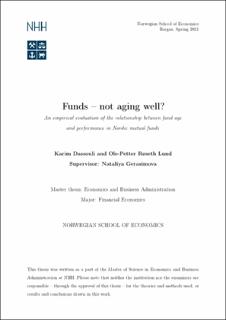Funds – not aging well? : an empirical evaluation of the relationship between fund age and performance in Nordic mutual funds
Master thesis
Permanent lenke
https://hdl.handle.net/11250/2772162Utgivelsesdato
2021Metadata
Vis full innførselSamlinger
- Master Thesis [4372]
Sammendrag
This study examines how fund age empirically affects the performance of Nordic mutual
funds. Our research questions are motivated by a high level of investments in actively
managed funds in the Nordic countries, yet we consider determinants of the abnormal
returns that these funds achieve to be understudied. The data set is free of survivorship
bias, and consists of 1198(net, 1138 gross) Nordic equity funds between January 2006
and February 2021. Employing multivariate panel regressions, controlling for other fund
characteristics, we investigate how fund age affects performance in terms of both beforeand
after-fee returns on a risk-adjusted basis. Second, we research how age affects how
funds are exposed to different types of risk, and whether it is affecting their investment
style. Further, we investigate whether portfolios sorted by fund age are able to outperform
risk-factor benchmarks. Lastly, we research persistence within age quintiles.
When controlling for fund attributes that typically affect fund performance, such as the
size and expense ratio of the fund, we find the relationship to be significantly positive,
i.e., that older funds perform better. We find evidence that that older funds are less
exposed towards total, market and unsystematic risk. We also find that investment styles
significantly differ across fund age, as older funds are more exposed to the four risk factors
proposed by Fama and French (2015b). We find that long-short portfolios of young
and old funds are not able to achieve risk-adjusted returns. Lastly, by employing an
analysis of persistence, we find evidence that neither old or young funds continue to outor
underperform over a time period of one year.
